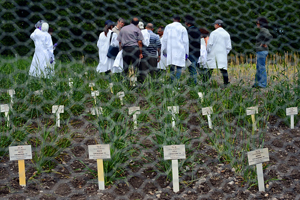In agriculture, genetic engineering has primarily been used to make crops resistant to pests and disease or able to survive the application of toxins, such as glyphosate. These traits do not occur naturally in the species in question. In practice, these genetically modified (GM) crops are poorly tested for safety, especially with respect to long term effects on the environment and human health. Safety studies are often conducted primarily by the same companies that manufacture and sell the GMOs in question.
 |
Proponents of plant genetic engineering often point out that selective breeding also alters a plant’s genes. While true, the comparison is misleading. All of our domesticated crop species were developed from their wild counterparts via selective breeding.
Selective breeding is a process in which a breeder collects the seed from plants with desired traits and sows them in a future growing season. For example, northern gardeners may save seed from the very first tomato that ripens on the vine. After several years of propagating these plants, the gardener will have a strain of the desired tomato variety that ripens early.
In contrast, common technologies to create GM crops splice genes from unrelated organisms into crop plants. In the case of Roundup Ready Corn, glyphosate-resistant bacterial genes are spliced into corn DNA. Unfortunately, the herbicide-resistant genes have crossed with weeds in the field, unintentionally breeding “super weeds” that can withstand glyphosate application.
Although this Roundup Ready technology was billed as a way to lessen the amount of herbicide sprayed on fields, GMO farmers are instead spraying more herbicides than ever.
Other countries use a precautionary principle with respect to GMOs, requiring them to be proved safe before being allowed in the marketplace. The U.S. has historically preferred a hands-off approach, allowing chemical and biotech companies to essentially regulate themselves.
The Trump administration is pushing to further de-regulate how GMOs get into the marketplace. A proposed rule would allow companies to determine for themselves whether their GMO poses a risk to plants. If they decide it does not, the USDA will opt not to regulate it. You can submit your own comments to the USDA on or before August 5, 2019.
GMOs are prohibited in organic agriculture. Choose organic food and fibers to support farmers and farming methods that care for the health of humans, wildlife, land, and water.
The Recently Proposed GMO Rule Change at the USDA is of Grave and Immediate Concern, Not President Trump’s Executive Order
Organic Insider
by Max Goldberg
Last week, President Trump received a tremendous amount of attention for signing an executive order directing the USDA, FDA and EPA to make it easier for genetically-engineering plants and animals to enter the food supply.
At face value, this seemed to be an ominous development. Yet, industry observers were not particularly impressed.
“His executive order was the equivalent of sound and fury, signifying nothing. It was merely propaganda for the biotech industry,” said George Kimbrell, Legal Director at the Center for Food Safety.
However, what should be alarming organic advocates right now is the recent action taken by the USDA nearly a week before the president’s executive order, something curiously absent from the USDA’s own press release page.

